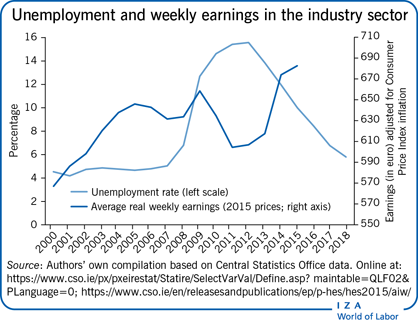Elevator pitch
Ireland was hit particularly hard by the global financial crisis, with severe impacts on the labor market. Between 2007 and 2013, the unemployment rate increased dramatically, from 5% to 15.5%, and the labor force participation rate declined by almost five percentage points between 2007 and 2012. Outward migration re-emerged as a safety valve for the Irish economy, helping to moderate impacts on unemployment via a reduction in overall labor supply. As the crisis deepened, long-term unemployment escalated. However, since 2013, there is clear evidence of a recovery in the labor market with unemployment, both overall and long-term, dropping rapidly.

Key findings
Pros
Unemployment has been on a steep downwards trajectory since 2013.
Migration acted as an important safety valve for the Irish economy in the aftermath of the crisis, whereby increases in unemployment led to rising emigration, thus alleviating the potential impact on the unemployment rate.
Labor force participation rates have stabilized after experiencing substantial falls during the crisis years.
Cons
Issues around future sources of labor supply are beginning to emerge.
In terms of unemployment, young men (aged 15–24) were hit particularly hard by the recession due to their high concentration within the construction sector.
Although the labor market has largely recovered since the crisis, Brexit constitutes a major challenge to the economy and labor market.